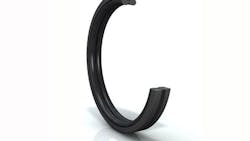Sealing material with optimum performance against ceramic coated rods
Trelleborg Sealing Solutions launched Turcon M30 sealing material withstands moving contact against hard ceramic coatings that are eco-friendly alternatives to chrome plating of rods in hydraulic aerospace applications. Tests have shown that the new compound increases seal life to reduce planned maintenance, extend flight hours and ultimately lower costs.
Colin Macqueen, Director of Technology at Trelleborg Sealing Solutions Americas, offered, "As more customers are seeking to eliminate chrome from their processes and components for environmental reasons, Trelleborg Sealing Solutions is being asked to provide seals that can be applied against a wide range of alternative surface coatings and treatments."
The U.S. Environmental Protection Agency lists chromium as one of the 17 most toxic chemicals. Because chromium is classified as carcinogenic, chrome-plated rods in hydraulic cylinders are being replaced with ceramic-coated ones using the High Velocity Oxygen Fuel (HVOF) process.
Chrome is inherently porous so it stores lubricant, prolonging the life of seals. The extremely hard, denser surface of tungsten carbide HVOF makes sealing more challenging.
The sealing material is the preferred option for hydraulic applications in aerospace flight controls and landing gear. It has operating temperatures from -196° to 260° C (-320° to 500° F) and is capable of withstanding pressures up to 35 MPa (5000 psi) for prolonged periods.
Click here for more information.


